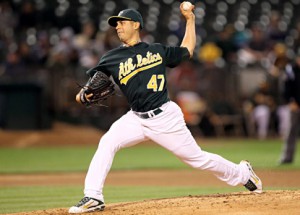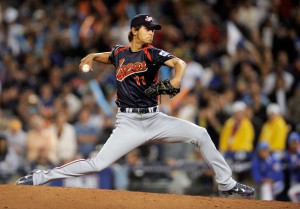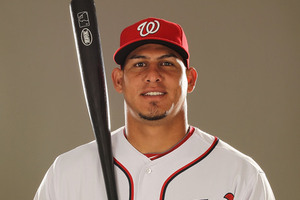
Nats go all-in for Gonzalez. Is it worth the cost? Photo Jed Jacobsohn/Getty Images via nydailynews.com
Well, the rumors turned out to be true. The Nats today traded four major prospects for Oakland’s Gio Gonzalez. Early reactions from fans on MLBtraderumors were all over the road; some said this will give Washington the Wild Card in 2012, others said Oakland fleeced Rizzo on the deal. Predictably, Keith Law said that the Nationals over-paid in terms of prospects, calling AJ Cole the gem of the deal but paying little attention to the other three players. Law is obsessed with ceiling arms and would rather have a projected #1 in Low-A versus a bird-in-hand guy like Peacock who has already debuted, so you have to take his opinion with a grain of salt.
First things first, how good do you think Gonzalez really is? Without having done major analysis of the guy, I’ve considered him in the past to be one of a slew of “#2 pitchers” on Oakland’s rotation. He’s put in two straight solid seasons pitching in Oakland, but we all know that Oakland’s a pitcher’s park with massive foul grounds that turn souvenirs into outs. However, even I was surprised when checking the Park Effects of Oakland; it only rates as a 97 or 98 in the Park effect measurements on baseball-reference.com for the last couple of years. By comparison, San Diego’s Petco Park (notoriously the best pitcher’s park in the league) was a 92/100. Other known pitcher’s parks in San Francisco, Tampa, Anaheim and Seattle all scored well below Oakland’s park this year. So, maybe the Oakland effect is over-stated by the media.
A quick glance at Gonzalez’s 2011 splits give me a bit more to go on; yes he was good in Oakland (10-5 with a 2.70 era) but he was more than servicable away (6-7, 3.62 era). When he’s winning, he’s fantastic (1.37 ERA in 16 wins), but his ERA in his no-decisions was BETTER than in his wins (1.09 in 4 no decisions), indicating that he had a few unlucky no-decisions and could have been a 20-game winner with a bit better run support. Looking a bit deeper at his advanced pitching stats shows that there’s nothing surprising; he’s got a normal BABIP of .287, his Fip was a pretty good 3.64 last year, and his xFIP was just slightly higher at 3.73. All good signs; there’s nothing that really indicates that his conventional numbers were really “lucky” in any way.
He’s a low ERA, so-so WHIP (1.32 last year), high walk, high strikeout lefty arm that should benefit from coming to the NL. Simple as that. He’s going to put guys on base and depends on a good defense to bail him out, but he also strikes out a ton of guys and can get himself out of jams.
One last thing that is a huge plus on Gonzalez; he’s under team control for FOUR more years. He’s heading into his first arbitration year this spring, is going to be a super-2, meaning the club controls him THROUGH 2015. Honestly, when you look at the cost of our prospects given up, a lot of that has to do with this fact here. A strong young guy who isn’t hitting FA for years to come? That’s pretty valuable in this league.
Ok, I’ve talked myself into being excited to see this guy in our rotation. Now, can I stomach the prospect loss? Here’s the four guys we sent over.
- AJ Cole
- Brad Peacock
- Tommy Milone
- Derek Norris
Or, put another way, Baseball America’s #3, #4, #9 prospects from our system, plus a 4th guy in Milone who didn’t rate but was relatively successful in a couple of late season 2011 stints and who has been successful at every level of the minors.
We have a tendency to over-rate our own prospects. I do especially, as someone who follows the minor leagues and has been tracking our pitching as it has risen for years. And especially for a team like Washington, that has struggled in recent years to develop talent. So when it comes time to cash them in for a pitcher like Gonzalez, sometimes it can be difficult to be objective about what we give up to get something we value in return. So, lets play best case/worst case for these four guys:
Best Case
- AJ Cole turns into a near #1 starter with an electric arm, in the mold of Justin Verlander.
- Brad Peacock finds a reliable third pitch and maybe even a 4th, and peaks as a #3 starter.
- Tommy Milone turns out to have 80 control and becomes this generation’s Tom Glavine, a serviceable back-end starter for years.
- Derek Norris recovers from Hamate bone surgery to become a .260/.410/.550 catcher with 20-homer capability.
Ok. Now what about worst case?
- AJ Cole burns out as a starter and turns into a hard-throwing middle to late innings reliever.
- Brad Peacock never harnesses a 3rd pitch and becomes a 2-pitch pony destined for middle relief.
- Tommy Milone gets routinely pounded in the majors as a guy with no out pitch and becomes a 4-A guy.
- Derek Norris never reaches his potential and settles in as a backup MLB catcher.
The reality will, of course, fall somewhere inbetween these two scenarios when all is said and done. Norris was always going to be traded; we have found the catcher of the future in Wilson Ramos, Norris has seen his stock fall with two consecutive sub-par offensive seasons and he’s got little chance to supplant Ramos in our organization. So I have no issues turning him into another player. Its the pitchers we have to worry about. In my Prospect Ceiling post I thought that Cole was a future #2, Peacock a future reliever and Milone a 4-A guy, somewhat mirroring the “worst case” scenario above. If that’s the case, then we’ve essentially gambled on Cole or Peacock turning into something more valuable than they appear to be capable of right now in return for Gonzalez.
Yes, the price of pitching has skyrocketed this off-season, and a lot of analysts will say that we’ve over-paid. But clearly the team has made a determination that Norris was expendable, Milone is topped out, and that Cole and Peacock are replaceable with guys like Meyer and Purke from the 2011 draft. Fair enough. For all the griping in yesterday’s post about how the Nats have “missed” on their starting pitcher goal, how the tides turn.
Can’t wait for 2012!

